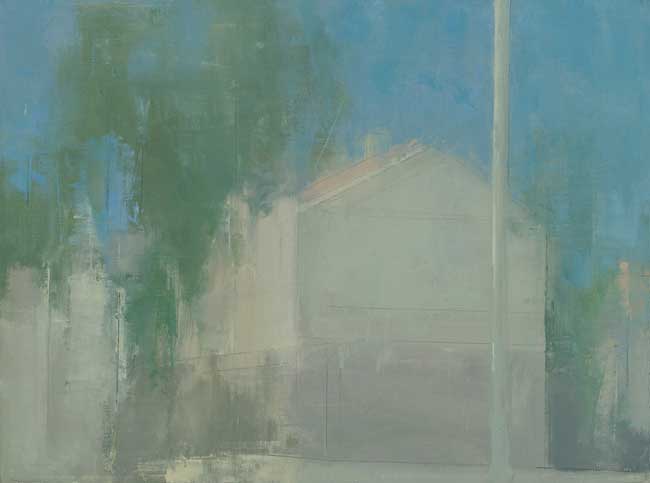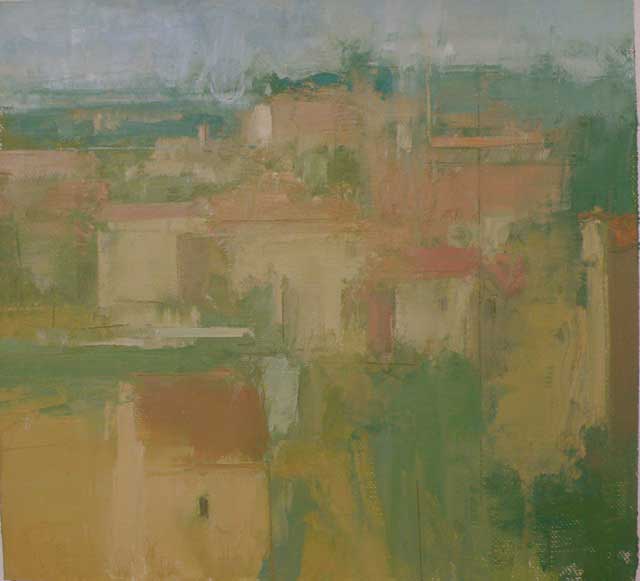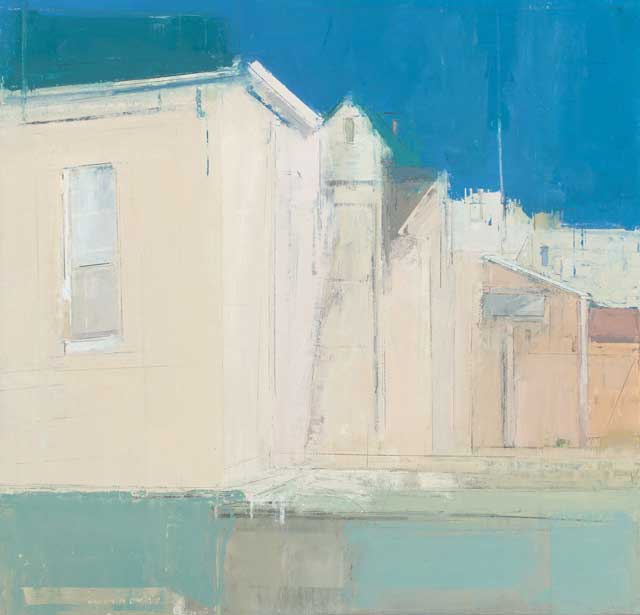LG What does “significant form” mean to you in painting. How far are you willing to edit nature to get this form or structure in your painting.
SS I remember conversations during the early years out of school, with my friend and teacher Seymour Remenick, about the idea that subject matter was not the same as content. Around school, in several ideological camps, there was a sense that what one painted was important. For instance, going down to South Philly and painting the oil refineries was hip and relevant, as opposed to doing a still life which was considered to be kind of old fashioned. I believed this stuff. I remember there was even someone I knew who did paintings of white dogs biting black dogs, or was it the other way around, black dogs biting white dogs? As if that somehow made it important. You get it – hint, hint – racial issues. And I remember someone else told me that if you put black people in your paintings it would carry more weight than say if you paint suburban houses. Ok, all these matters of race and meaning are weighty ones and sociology is a deep discipline, but the painter swims in very different waters.
Subject matter, or the “what is it” part of what an image is, on many levels really doesn’t matter, it’s the excuse for something else, the smearing around of pigment. Or let’s say, it’s not the primary motivation. The basements of Italian museums are filled with Flagellations of Christ but why do we pull our hair out with such pleasure in front of ones by Piero and Fra Angelico? Not because of the story, because all those guys are doing the same story; it is because of how they have told the story, in form. I’ve seen students cry in front of Piero and Giotto, students who have no idea what the “story” is that’s being told. So there must be another story right? And that is the narrative of form, how the picture is built abstractly. Not what is it, but how is it? Where are the lights and where are the darks, what color are they and what shape are they and, what are the edges like? And of course this implies, how do they all fit together, what is the formal unity in which all the parts contribute to? And from all that, emotion, impact and ultimately meaning, all flow.
When we work either outside or inside, there is no obligation to what we see in terms of how much to edit or not to edit. That depends on what we want from or want to do in the painting. Nature is overabundant, simply too much information, way, way, way too much. And as Whistler said to his students, “Paint what you see and wait until you see what you paint.” Meaning, that it is not simply a matter of painting what we see because we indiscriminately see too much and the more we look the more we see and it all gets piled on top of itself as an incoherent disordered collection of observations. This is the fallacy and pitfall of the idea of realism. Was Giotto a realist, or was Piero a realist or how about Praxiteles or Pisano? Even someone like Canaletto, who paintings are full of lots of information, didn’t paint what he saw in terms of copying – he organized, composed, and rearranged, like a kind of conceptual Photoshop. We use nature as we need to and that means, we leave out a lot, we suppress, accentuate, modify, re tune, magnify, etc, we are after all, making a painting and not pasting down the actual nature itself.
To simply accept everything “out there” is like a visual terror unleashed on our minds by misuse of camera mentality and by the application of certain kinds of post enlightenment scientific measuring principles – and now, by the regimens of the reactionary ateliers that perceive modernism as somehow the destruction of painting, all this has left us really confused. (Don’t get me started.) Our job as painters is to dream ourselves away from the idea of representation as a stale inventory list, leave that to people who work in banks and actuarial offices. We want to be unreal, to be artificial, synthetic, to make an imaginary invention built around consciously composed structure, rooted in various ways to what is seen but also about stimulating feeling, mood and desire. I am drawn to a painting not because of the accuracy of the information retrieval system or because it looks like something polite from 300 years ago, but because of how it knocks me off my ass by way of the passion of it’s appeal. And for me, that is only by way of form, not through nostalgic or sentimental story telling. I love the early work of Jacob Lawrence, the Migration Series and of course he is telling a story, as Piero was telling a story, but it’s the graphic impact of those paintings that rivets our eyes, and that is his genius as a storyteller. Lots of other people told that story with words, but his strength is the image as an inventive composer.








Very inspiring and wise !
Outstanding! Thanks so much for this interview. He’s one of my favorites and I would love to take his class. He talks about a lot of the things I’m struggling with right now. Maybe Santa will reward me for being good all year.
Some great intense thoughts on painting and seeing. I really like the ideas he was talking about regarding the difference between ‘landscape’ and ‘scenery’, and how painters need to edit out the observed, see-able world, and focus on the construction of what’s happening on the picture plane. His work speaks of a deep involvement with the world, and it shows. Thanks
Great interview Stuart and Larry. Many thanks and will pass this on to the students etc… Best, IH
Thank-you very much Stuart and Larry… nice interview.
It is thrilling to read this discussion which has much to consider and digest.
Yeah, this was a really good interview. Painting as connected to a Kinks chord or whatever it is that grabs us in the world of our senses is really the game and Stuart has a great way of conveying the excitement of it with words and, of course, with his art.
thanks to both you.
dm
Awesome interview, Larry! I ended up doing his workshop in Philly and had a great experience. He is an incredible artist and instructor, as well as a great person. A lot of what was touched on in the interview was discussed in the class as well. Nice to have this wonderful resource to read over and really digest. My seed is taking root!
Hi Larry,
This is one of those interviews that I want to read every day. So many truths and poetic ways of describing the way we think and see as artists. LOVED IT!!
Thanks tons, love your blog!
Happy Holidays to YOU
Terrific interview! Questions and answers all so thoughtful, original, articulate, and helpful. I’d like to take a class in California in spring or early summer.
Absolutely outstanding!
This should be required reading for every art student and I would go s far as saying that every working artist would benefit from reading this often. So full of experience and intelligence! The paintings and drawings are truly beautiful as well.
Thanks for taking the time with this Larry and Stuart.
Thanks very much for doing this interview. Shils has always been one of my favorite painters, and this was wonderful to read and see. I particularly appreciate seeing his sketches, which are amazing.
Great interview on an inspiring artist! Much appreciated.
I got a chance to have Bill Scott in my studio during grad school and was really inspired by his perspective on observational painting. It makes it even more exciting knowing that a painter that I respect as much as Stuart holds Bill in such high regards as well. Great interview! Thanks, Dustin O’Hara
Love your stuff man. Very unique love the abstract qualities and the brightness of the colors. Really rate-type look. Ultra cool.
Great interview on an inspiring artist. Great collections of paintings there.